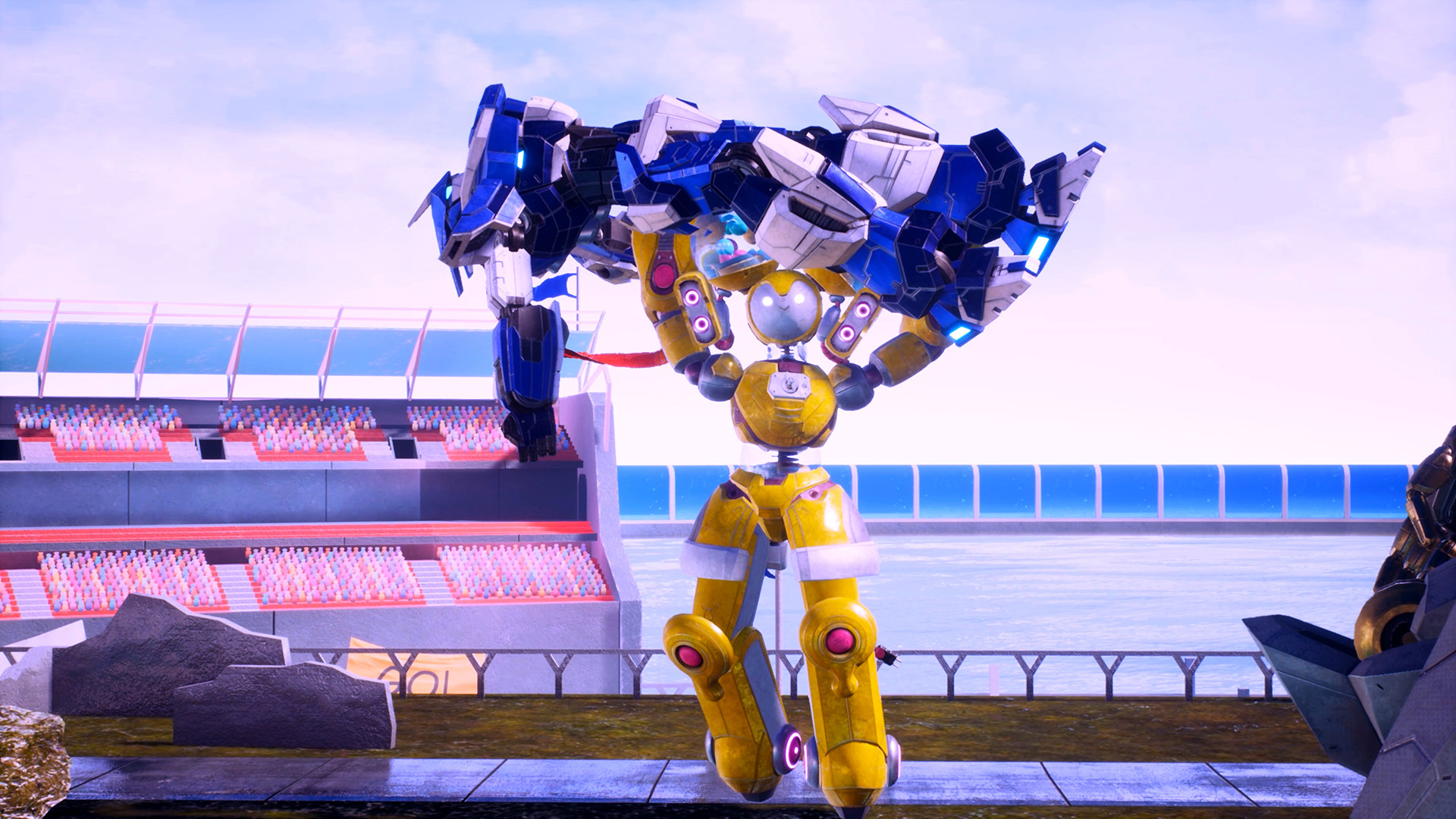Our Verdict
Perhaps an online community would provide a spark, but as it is, it’s pretty rusty.
PC Gamer's got your back
What is it? A disappointing way to have giant mechs fight one another.
Expect to pay: $30/£25
Developer: Modus Studios Brazil
Publisher: Modus Games
Reviewed on: GeForce GTX 1650, AMD Ryzen 5 3550H, 8 GB RAM
Multiplayer: 2-4 (local and online)
Link: Official site
Giant robots. Stick those two words in front of one another, in that order, and something deep in the human brain lights up. Make them fight one another (what else are they good for, after all?), and you might even get an involuntary squeak of delight. This game is about nothing but enormous mechs punching, kicking, and shooting one another; but something’s not quite right. And I’m not talking about the wrestler fish with nipples the size of transit vans.
To understand what Override 2 is, it helps to understand what it isn’t. It’s a beat ‘em up and, sure, that immediately tells you a lot about the experience. Given the clear influence certain Japanese movies and TV shows have had (this sequel wears its heart on its huge metal sleeve with Ultraman DLC), you’d be forgiven for expecting something akin to an anime beat ‘em up. The speed is a far cry from the lightning pace of such games, however; and while 20 mechs to choose from is a decent selection, it’s not a patch on the encyclopedic cast of, say, a Naruto title.

It’s no Street Fighter, either. Generally speaking, each mech is limited to four to six special moves and an ultimate, no one of which can be chained smoothly into another. Some basic punch and kick combos are possible, but nothing particularly lengthy or flashy. With each arm and leg assigned to a separate button, it’s closer to Tekken than anything else, although the system here lacks the depth and flexibility of Bandai Namco’s legendary series.
The game you’d expect Override 2 to resemble most closely is, well… Override 1. Which it does. Sort of. The first game didn’t exactly set the fighting game scene alight, but it was full of great ideas ripe for further development. A story mode about repelling kaiju, balancing quick but weak strikes with charged, more powerful blows, a co-op mode where up to four people controlled the same mech, a heat meter that prevents constant button bashing—none of which is present here.
Bots and pieces
Override 2 moves along on the unpredictable trolley wheels of bizarre design decisions, the most noticeable of which is the one to drop almost everything that made the first game interesting and unique. With a little tweaking, the combination of giant monsters and co-op mech piloting could have given us the quality Pacific Rim tribute that the first game had in its sights. Sadly, that was not to be.
Instead of a story mode, there is Leagues, an awkward and underwhelming hybrid of online and offline gameplay. There’s chatter from your ‘agent’ between matches—the idea is that the mechs are fighting in a kind of future sport—but it’s thoroughly uninteresting, and fails to tell any kind of coherent story. That wouldn’t necessarily be a problem if Leagues was… you know.... better.
Each game mode is presented as its own league. The idea, basically, is that you repeatedly play matches in each to work your way up from F to S. You also earn in-game cash as you go, with bonuses won for meeting optional objectives such as blocking a set number of hits. This currency is used for unlocking more mechs for use in Leagues, as well as customisation bits and bobs. I never feel the need to do much customising, though. I’m simply not invested enough to care what picture is used for my avatar, and the majority of mech decoration is limited to different coloured arms, legs, etc.
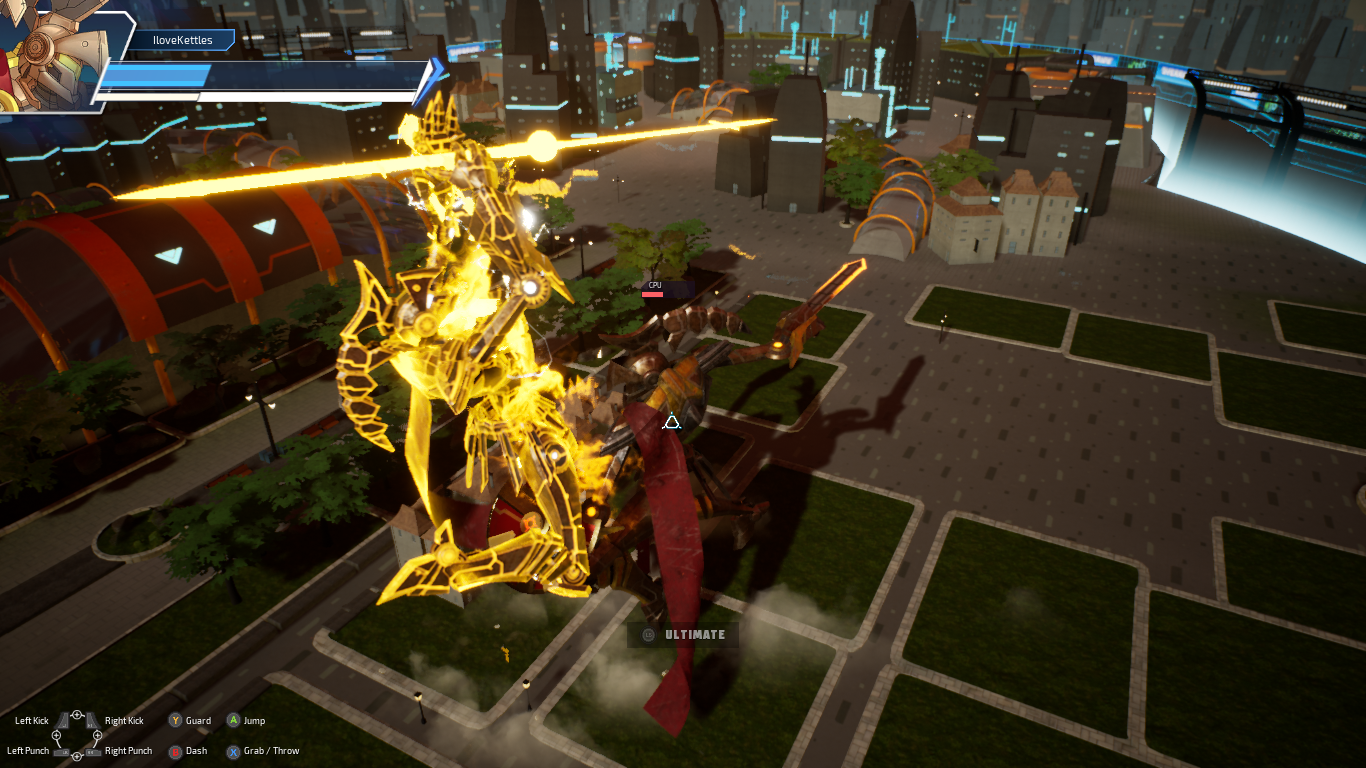
After each match, a random selection of game modes are made available to play, rather than all of them. Why? I have no idea. It’s yet another inexplicable decision. It certainly doesn’t help in the game’s greatest challenge; finding somebody to play against. Each time you trigger a match in Leagues, Override 2 tries to find online opponents for you, with the option to skip the search and battle bots instead. Despite playing across several different days, I only once found a human opponent.
Circuit breaker
The painfully small number of people playing at any one time perhaps can't be helped in a niche game, but the fragmentation and distribution of modes could've been. There’s a Quick Play option at the main menu to jump into any available game, but I’m not sure if this includes Leagues matches. Either way, it didn’t help.
The struggles are a shame because, once you dig past the baffling design decisions and inexplicable omissions from the first game, there’s a decent fighter in Override 2. The mechs (most of which return from the first game, largely unchanged) are all pleasingly unique and all play very differently. You wouldn’t expect a robot with a huge CRT monitor for a head to fight in the same way as a metal Roman centurion, after all. Well I wouldn’t, anyway.
Override 2 is a faster-paced fighter than the first game, and as a result, loses much of the sense of enormous, weighty mechs clashing. Initially, it feels a bit like a mindless button-basher. Combine the extremely limited combo opportunities with special moves activated by simply hitting two buttons at once, and there doesn’t seem to be much room for skill. Stick with it, though, and you’ll realise that’s not quite true.
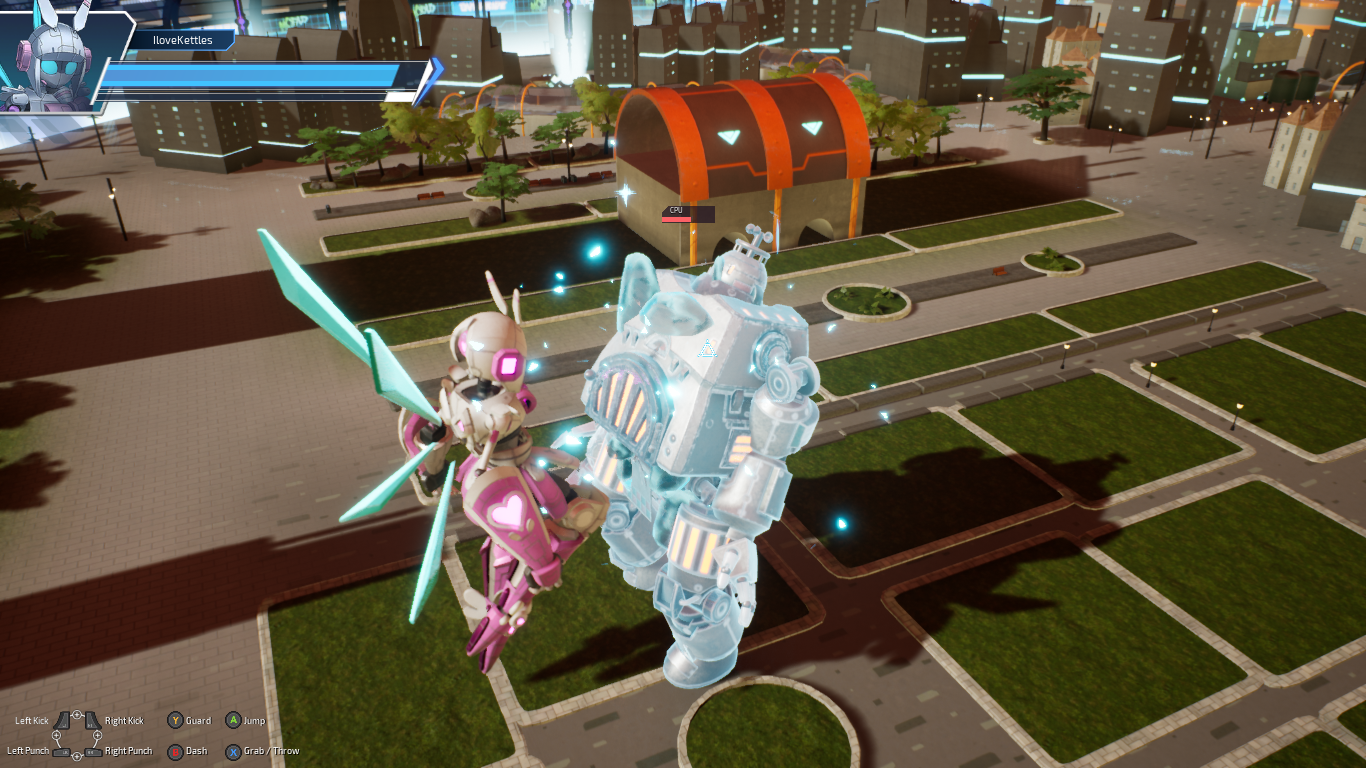
There’s a split-second delay before the activation of each special move. As the attacker, you need to make sure that you don’t leave yourself vulnerable. As the defender, you can use that briefest of pauses to block or, better yet, reposition yourself to counterattack. Even the basic element of throwing your opponent can work to your advantage in ways you won’t find in other beat ‘em ups. Arenas contain environmental hazards and, in modes with more than two players, fallen mechs explode after a short time. Time a thrown metallic corpse correctly for a satisfying advantage.
My favourite map is Cakeland. Wonderfully silly name? Check. Strawberries big enough to crush a large family? Check. Sections of the ground that move up and down? Also check. Moving platforms such as this add another layer of strategy, and it’s a shame that they’re not used in more of the game. They limit when and where certain moves can be used effectively.
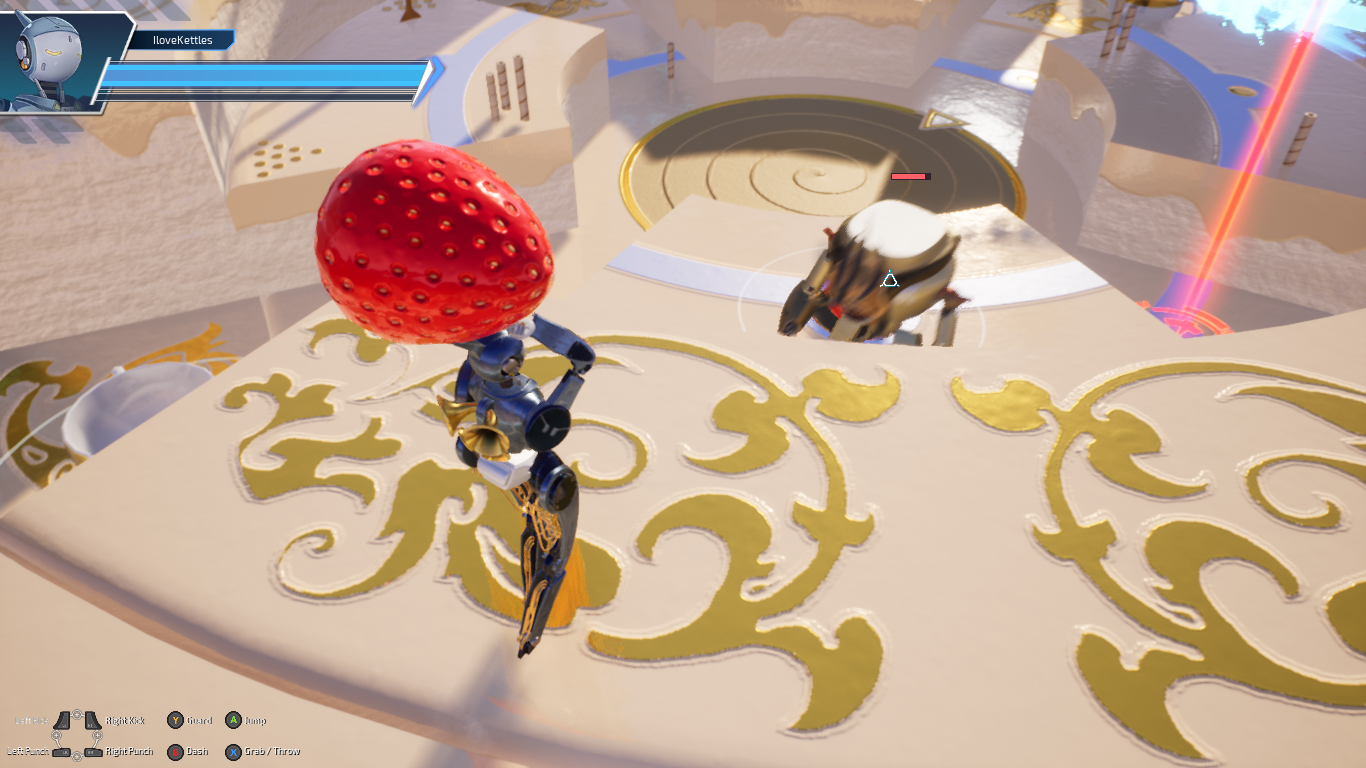
Needs rust
One thing that’s survived from the first game is the scattering of limited-use weapons across the maps. This doesn’t add as much as you might hope, and in fact, the game is at its best when you ignore them. Guns feel unfair thanks to generous auto-targeting, and melee weapons tend to be too slow, or afford you an unfairly long reach.
Returning to Leagues, most of the modes can be classified as simple 1v1, 2v2, or 1v1v1v1 fights. The two most interesting deviations are Control—a mode for four players, where the mech which stays inside a shrinking, moving circle for the longest wins (so long as they survive)—and Xenoswarm. The latter is the most challenging mode as the game currently stands. With multiple alien mechs after you (none of which, sadly, are playable), it’s a fight for survival that asks more of you than usual.
In fact, Xenoswarm’s challenge serves to highlight the damage that a lack of players is doing to Override 2. This mode’s difficulty comes solely from the fact that there are more opponents than usual to defeat before the match ends. In any other mode, it’s painfully clear that the AI isn’t quite up to scratch. Whack it up to maximum, and opponents are more aggressive—and pay more attention to the randomly placed glowing circle that slowly charges Ultimate meters—but still doesn’t require mastery of the systems to overcome. There is a good fighter in there somewhere, but it’s difficult to see when you’re stuck with bots that are only putting in a half-hearted effort.
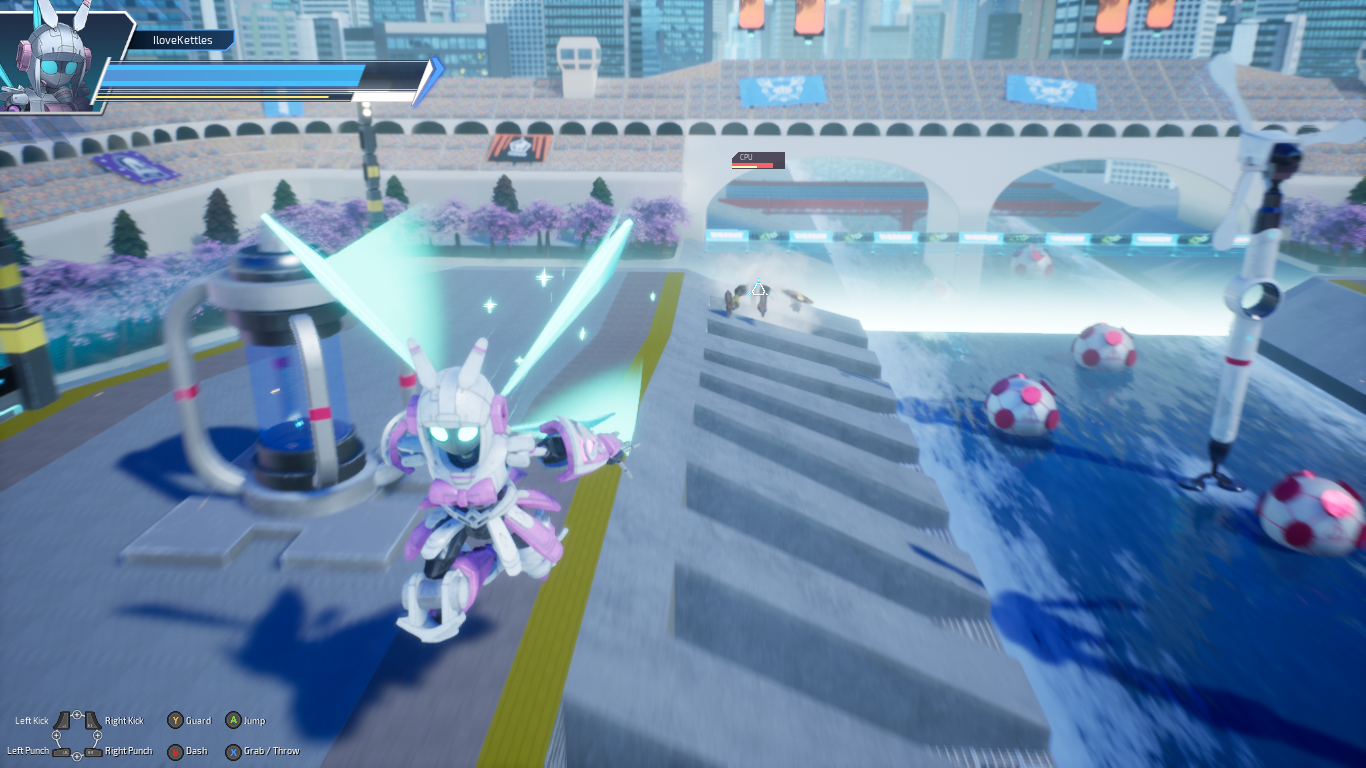
It really is a shame, because I have a genuine fondness for many of the mechs. One of my favourites is the returning Metageckon, who is basically Mechagodzilla but red. I mean, come on. A robot dinosaur? If you don’t think that’s cool, you’re dead to me.
Other mechs include a giant robot unicorn (that stands on two legs), a breakdancing frog, a mech that could have fallen straight out of Power Rangers, and that wrestling fish with star-shaped metal nipples that I really can’t get over. It may fall short in several other areas, but Override 2 gives its mechs character in spades.
There’s a solid fighting foundation here and, sometimes, you can see it in moments of victory (or even rare instances of defeat) when you find a perfect counter to an attack, or fail due to sloppiness. In fact, this would be good for bouts of family fun; and that’s no snide, backhanded compliment. The overarching simplicity opens the experience up to people of varying skill levels and familiarity with videogame controls (for brief sessions, if not enthusiastically lengthy ones). Beyond that, it’s difficult to recommend for now. It’s far from a terrible game—but it mechs no moves towards being a particularly good one, either.
Perhaps an online community would provide a spark, but as it is, it’s pretty rusty.
